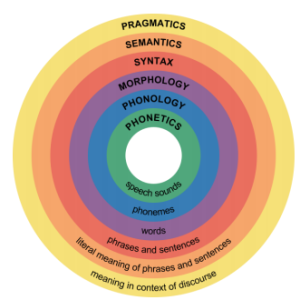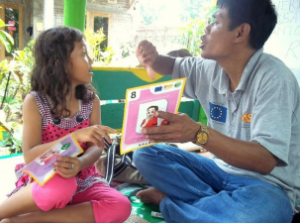11 Communication, Language and Literacy Development in Middle Childhood
Chapter Objectives
After this chapter, you should be able to identify:
- Branches of linguistics
- The process of learning to read
- Challenges in learning to read and write
- The influences of digital technology on communication, language and literacy
INTRODUCTION
In the middle years communication, language and literacy skills continue to develop. Children become skilled communicators, using both verbal and non-verbal communication. They use fluent and grammatically correct speech including correct verb tenses, word order and sentence structure. Their vocabulary continues to expand to include subject specific terminology, synonyms and local slang. They increase the length of recalled stories, tell jokes and adapt their communication to meet the needs of their listeners and communication partners. During this period of development phonological awareness supports their ability to read and write. Most children successfully adopt a variety of strategies to support them to read fluently and for meaning. As readers, they read for pleasure, to seek information and for other purposes and can think critically about the content they are reading. Equally during this period of development children are writing with increasing complexity, and writing in different forms, adapting their writing to suit the audience, (Ontario Ministry of Education, 2014)
introduction to linguistics
Human language is such a complex topic that there is an entire field, linguistics, devoted to its study. Linguistics views language in an objective way, using the scientific method and rigorous research to form theories about how humans acquire, use, and sometimes abuse language. There are a few major branches of linguistics, which it is useful to understand in order to learn about language from a psychological perspective.
Major Branches of Linguistics
This diagram outlines the various subfields of linguistics, the study of language. These include phonetics, phonology, morphology, syntax, semantics, and pragmatics.

Figure 18.1: Major branches of linguistics (Image is in the public domain)
Phonetics and Phonology
A phoneme is the smallest unit of sound that makes a meaningful difference in a language. The word “bit” has three phonemes, /b/, /i/, and /t/ (in transcription, phonemes are placed between slashes), and the word “pit” also has three: /p/, /i/, and /t/. In spoken languages, phonemes are produced by the positions and movements of the vocal tract, including our lips, teeth, tongue, vocal cords, and throat, whereas in sign languages phonemes are defined by the shapes and movement of the hands. English contains about 45 phonemes.
Graphemes are written symbols that represent sounds (phonemes). There are approximately 250 graphemes in the English language. Graphemes can be a single letter or a combination of letters. For example, the word “bead” has 3 phonemes b/ea/d. “Ea” is a grapheme; two letters that represent the sound of a long “e” when writing the word “bead”.
Whereas phonemes are the smallest units of sound in language, phonetics is the study of individual speech sounds; phonology is the study of phonemes, which are the speech sounds of an individual language. These two heavily overlapping subfields cover all the sounds that humans can make, as well as which sounds make up different languages.
Morpheme and Morphology
A morpheme is a string of one or more phonemes that makes up the smallest units of meaning in a language. Some morphemes, such as one-letter words like “I” and “a,” are also phonemes, but most morphemes are made up of combinations of phonemes. Some morphemes are prefixes and suffixes used to modify other words. For example, the syllable “re-” as in “rewrite” or “repay” means “to do again,” and the suffix “-est” as in “happiest” or “coolest” means “to the maximum.”
Morphology is the study of words and other meaningful units of language like suffixes and prefixes. A morphologist would be interested in the relationship between words like “dog” and “dogs” or “walk” and “walking,” and how people figure out the differences between those words.
Syntax
Syntax is the set of rules of a language by which we construct sentences. Each language has a different syntax. The syntax of the English language requires that each sentence have a noun and a verb, each of which may be modified by adjectives and adverbs. Some syntaxes make use of the order in which words appear, while others do not.
Syntax is the study of sentences and phrases, or how people put words into the right order so that they can communicate meaningfully. All languages have underlying rules of syntax, which, along with morphological rules, make up every language’s grammar. An example of syntax coming into play in language is “Eugene walked the dog” versus “The dog walked Eugene.” The order of words is not arbitrary—in order for the sentence to convey the intended meaning, the words must be in a certain order.
Semantics and Pragmatics
Semantics, generally, is about the meaning of sentences. Someone who studies semantics is interested in words and what real-world object or concept those words denote, or point to.
Pragmatics is an even broader field that studies how the context of a sentence contributes to meaning. For example, someone shouting “Fire!” has a very different meaning if they are in charge of a seven-gun salute than it does if they are sitting in a crowded movie theater. Every language is different. In English, an adjective comes before a noun (“red house”), whereas in Spanish, the adjective comes after (“casa [house] roja [red].”) In German, you can put noun after noun together to form giant compound words; in Chinese, the pitch of your voice determines the meaning of your words. in American Sign Language, you can convey full, grammatical sentences with tense and aspect by moving your hands and face. But all languages have structural underpinnings that make them logical for the people who speak and understand them (OER Services, n.d.).

Figure 18.2: As speakers of Chinese, these children would understand the importance of pitch. (Image by joan vila is licensed under CC BY 2.0)
Cognitive Language and Communication
When learning one or more languages in middle childhood, children are able to understand that there are many complex parts including comprehension, fluency, and meaning when communicating. The following are areas of cognitive language and communication.
Lexicon
Every language has its rules, which act as a framework for meaningful communication. But what do people fill that framework up with? The answer is, of course, words. Every human language has a lexicon—the sum total of all of the words in that language. By using grammatical rules to combine words into logical sentences, humans can convey an infinite number of concepts.
Grammar
Because all language obeys a set of combinatory rules, we can communicate an infinite number of concepts. While every language has a different set of rules, all languages do obey rules. These rules are known as grammar. Speakers of a language have internalized the rules and exceptions for that language’s grammar. There are rules for every level of language—word formation (for example, native speakers of English have internalized the general rule that -ed is the ending for past-tense verbs, so even when they encounter a brand-new verb, they automatically know how to put it into past tense); phrase formation (for example, knowing that when you use the verb “buy,” it needs a subject and an object; “they buys” is wrong, but “they buys a gift” is okay); and sentence formation.
Older children are also able to learn new rules of grammar with more flexibility. While younger children are likely to be reluctant to give up saying “I goed there”, older children will learn this rather quickly along with other rules of grammar.
Vocabulary
One of the reasons that children can classify objects in so many ways is that they have acquired a vocabulary to do so. By fifth grade, a child’s vocabulary has grown to 40,000 words. It grows at a rate that exceeds that of those in early childhood. This language explosion, however, differs from that of younger children because it is facilitated by being able to associate new words with those already known, and because it is accompanied by a more sophisticated understanding of the meanings of a word.
Context
Words do not possess fixed meanings but change their interpretation as a function of the context in which they are spoken. We use contextual information—the information surrounding language—to help us interpret it. Context is how everything within language works together to convey a particular meaning. Context includes tone of voice, body language, and the words being used. Depending on how a person says something, holds their body, or emphasizes certain points of a sentence, a variety of different messages can be conveyed. For example, the word “awesome,” when said with a big smile, means the person is excited about a situation. “Awesome,” said with crossed arms, rolled eyes, and a sarcastic tone, means the person is not thrilled with the situation (OER Services, n.d.).

Figure 18.3: Context helps us understand meaning. (Image is licensed under CC0)
New Understanding
Those in middle and late childhood are also able to think of objects in less literal ways. For example, if asked for the first word that comes to mind when one hears the word “pizza”, the younger child is likely to say “eat” or some word that describes what is done with a pizza. However, the older child is more likely to place pizza in the appropriate category and say “food”. This sophistication of vocabulary is also evidenced by the fact that older children tell jokes and delight in doing so. They may use jokes that involve plays on words such as “knock-knock” jokes or jokes with punch lines. Young children do not understand play on words and tell “jokes” that are literal or slapstick, such as “A person fell down in the mud! Isn’t that funny?” (Lumen Learning, n.d.).
Learning to Read
A huge milestone in middle childhood is learning to read and write. While the foundations of this were laid in infancy and early childhood, formal instruction on this process usually happens during the school-age years. There isn’t always complete agreement on how children are best taught to read. The following approaches to teaching reading are separated by their methodology, but today, models of reading strive for a balance between the two types of reading methods because they are both recognized as essential for learning to read.
- A phonics-based approach teaches reading by making sure children can understand letter-sound correspondences (how letters sound), automatically recognize familiar words, and decode unfamiliar words. This ability to break the code of reading allows children to read words they have never heard spoken before.
- The whole-language approach attempts to teach reading as naturally as possible. As the sounds of words don’t have meaning, the focus is on reading words and sentences in context (such as real books), rather than learning the sounds and phonemes that makeup words.
Learning Difficulties
When children don’t seem to be developing or learning in the typical pattern one might be assessed for a disorder or disability. What is a learning disorder or disability? In the next section we’ll learn about the spectrum of disorders and how they may impact many areas of the child’s life.
A learning disorder is a classification of disorders in which a person has difficulty learning in a typical manner within one of several domains. Types of learning disorders include difficulties in reading (dyslexia), mathematics (dyscalculia), and writing (dysgraphia). These disorders are diagnosed with certain criteria.
Children with learning challenges may learn differently in relationship to a a specific area, a specific task or a type of activity related to education.
Children with learning challenges are usually identified in school because this is when their academic abilities are being tested, compared, and measured. In the Diagnostic and Statistical Manual of Mental Disorders -DSM-5, a qualified person will make a diagnosis, identified causes, and will make a treatment plan for disorders and disabilities. The diagnosis of specific learning disorder was added to the DSM-5 in 2013.
The DSM does not require that a single domain of difficulty (such as reading, mathematics, or written expression) be identified—instead, it is a single diagnosis that describes a collection of potential difficulties with general academic skills, simply including detailed specifications for the areas of reading, mathematics, and writing. Academic performance must be below average in at least one of these fields, and the symptoms may also interfere with daily life or work. In addition, the learning difficulties cannot be attributed to other sensory, motor, developmental, or neurological disorders (Lally & Valentine-French, 2019). The following is an example of the DSM-5 – learning disorders.
Learning Disorders
- Dyslexia – Reading
- Dyscalculia – Mathematics
- Dyspraxia – Motor Coordination
- Dysgraphia – Writing
- Auditory Processing Disorder – Hearing
- Visual Processing Disorder – Visual
Speech and Language Disorders
- Aphasia – Loss of expressive and or receptive language
- Articulation Disorder – Distortions or substitutions in the production of speech sounds
- Fluency Disorders – Difficulty speaking in a flowing way
- Voice Disorders – differences in voice quality, pitch or loudness
Learning Disorders or Disabilities
Dyslexia
Dyslexia, sometimes called “reading disorder,” is the most common learning disability; of all students with specific learning disabilities, 70%–80% have deficits in reading. The term “developmental dyslexia” is often used as a catchall term, but researchers assert that dyslexia is just one of several types of reading disabilities. A reading disability can affect any part of the reading process, including word recognition, word decoding, reading speed, prosody (oral reading with expression), and reading comprehension.
Dyscalculia
Dyscalculia is a form of math-related disability that involves difficulties with learning math-related concepts (such as quantity, place value, and time), memorizing math-related facts, organizing numbers, and understanding how problems are organized on the page. Dyscalculics are often referred to as having poor “number sense.”
Dyspraxia
Children who have motor skills substantially below what is expected for their age are diagnosed with dyspraxia – or developmental coordination disorder (DCD) as it is more formally known. They are not lazy, clumsy or unintelligent – in fact, their intellectual ability is in line with the general population – but they do struggle with everyday tasks that require coordination.

Figure 18.4: Children with learning challenges are usually identified in school because this is when their academic abilities are being tested, compared, and measured. (Image by pan xiaozhen on Unsplash)
Dysgraphia
The term dysgraphia is often used as an overarching term for all disorders of written expression. Individuals with dysgraphia typically show multiple writing-related deficiencies, such as grammatical and punctuation errors within sentences, poor paragraph organization, multiple spelling errors, and excessively poor penmanship.
Auditory Processing Disorder
A processing deficit in the auditory modality that spans multiple processes is auditory processing disorder (APD). To date, APD diagnosis is mostly based on the utilization of speech material. Unfortunately, acceptable non-speech tests that allow differentiation between an actual central hearing disorder and related disorders such as specific language impairments are still not adequately available.
Visual Processing Disorder
Difficulty processing or interpreting visual information is referred to as visual processing disorder (VPD). Kids with visual processing issues may have difficulty telling the difference between two shapes or finding a specific piece of information on a page (Ludwig, Fuchs, Kruse, Uhlig, Kotz, & Rübsamen, 2014).
Table 18.1: Summary of Learning Disabilities
| Disability | Difficulties | Effects |
| Dyslexia | Difficulty with reading | Problems reading, writing, spelling |
| Dyscalculia | Difficulty with math | Problems doing math problems, understanding time, using money |
| Dyspraxia (Sensory Integration Disorder) | Difficulty with fine motor skills | Problems with hand-eye coordination, balance manual dexterity |
| Dysgraphia | Difficulty with writing | Problems with handwriting, spelling, organizing ideas |
| Auditory Processing Disorder | Difficulty hearing difference between sounds | Problems with reading, comprehension, language |
| Visual Processing Disorder | Difficulty interpreting visual information | Problems with reading, math, maps, charts, symbols, pictures |
Table 18.1- Summary of Learning Disabilities (Dyspraxi by The Conversation is licensed under CC BY-ND 4.0)
speech and language disorders
Aphasia
A loss of the ability to produce or understand language is referred to as aphasia. Without the brain, there would be no language. The human brain has a few areas that are specific to language processing and production. When these areas are damaged or injured, capabilities for speaking or understanding can be lost, a disorder known as aphasia. These areas must function together in order for a person to develop, use, and understand language.
Articulation Disorder
An articulation disorder refers to the inability to correctly produce speech sounds (phonemes) because of imprecise placement, timing, pressure, speed, or flow of movement of the lips, tongue, or throat (NIDCD, 2016, as cited in Paris, Ricardo, Raymond, & Johnson, 2021). Sounds can be substituted, left off, added or changed. These errors may make it hard for people to understand the speaker. They can range from problems with specific sounds, such as lisping to severe impairment in the phonological system. Most children have problems pronouncing words early on while their speech is developing. However, by age three, at least half of what a child says should be understood by a stranger. By age five, a child’s speech should be mostly intelligible. Parents should seek help if by age six the child is still having trouble producing certain sounds. It should be noted that accents are not articulation disorders (Medline Plus, 2016a, as cited in Paris, Ricardo, Raymond, & Johnson, 2021).
Fluency Disorders
Fluency disorders affect the rate of speech. Speech may be labored and slow, or too fast for listeners to follow. The most common fluency disorder is stuttering.
Stuttering is a speech disorder in which sounds, syllables, or words are repeated or last longer than normal. These problems cause a break in the flow of speech, which is called dysfluency (Medline Plus, 2016b, as cited in Paris, Ricardo, Raymond, & Johnson, 2021). About 5% of young children, aged two-five, will develop some stuttering that may last from several weeks to several years (Medline Plus, 2016c, as cited in Paris, Ricardo, Raymond, & Johnson, 2021). Approximately 75% of children recover from stuttering. For the remaining 25%, stuttering can persist as a lifelong communication disorder (National Institute on Deafness and other Communication Disorders, NIDCD, 2016, as cited in Paris, Ricardo, Raymond, & Johnson, 2021). This is called developmental stuttering and is the most common form of stuttering.
Brain injury, and in very rare instances, emotional trauma may be other triggers for developing problems with stuttering. In most cases of developmental stuttering, other family members share the same communication disorder. Researchers have recently identified variants in four genes that are more commonly found in those who stutter (NIDCD, 2016, as cited in Paris, Ricardo, Raymond, & Johnson, 2021).
Voice Disorders
Disorders of the voice involve problems with pitch, loudness, and quality of the voice (American Speech-Language and Hearing Association, 2016, as cited in Paris, Ricardo, Raymond, & Johnson, 2021). It only becomes a disorder when problems with the voice make the child unintelligible. In children, voice disorders are significantly more prevalent in males than in females. Between 1.4% and 6% of children experience problems with the quality of their voice. Causes can be due to structural abnormalities in the vocal cords and/or larynx, functional factors, such as vocal fatigue from overuse, and in rarer cases psychological factors, such as chronic stress and anxiety (Lally & Valentine-French, 2019).

Figure 18.5: Speech therapy. (Image by EU Civil)
Digital technology and screens
In recent years digital technology has profoundly changed the way we live and work. At work and in everyday life it is almost impossible to avoid engaging with screens. Almost everything we do involves some form of digital technology and contact with a screen from shopping and banking, to communicating with others as examples.
In this text we are concerned with children’s development. How does digital technology including the use of screens influence children’s development of language and literacy? This includes children’s exposure to screens as well how screen use by others may impact them. In the past screens generally referred to television, but now the term is used to include computers, tablets and Smart phones. Media developers have been quick to respond to this demographic with programming and developing apps for the youngest viewers and users. There are hundreds of videos posted on You Tube and Tik Tok for example, created with young children in mind.
We now know that children are also affected by the screen use of others referred to as second hand screen time (The Conversation, 2020). Smart Phones have made it possible to connect with others almost anywhere and to access information at our fingertips. Digital technology has blurred boundaries between work and home life. For these reasons and more, parents and caregivers can be easily distracted by their phones. Distracted caregiving may negatively impact the quality of the relationship between a child and a primary caregiver. A child may come to believe that the content on the caregiver’s phone is more important than they are. This inattention and lack of direct attention can have an adverse effect on communication and language development (The Conversation, 2020).
So how does this all affect children’s brains and development? Since digital technology and the recent access to screens is fairly recent, researchers are still trying to determine the extent to which development is influenced and make recommendations (Canadian Paediatric Society, 2017). In 2017 the Canadian Paediatric Society surveyed its members and released a position statement on screen time for children. The position statement recommends that physicians counsel families on 4Ms: Minimizing screen time, mitigating the potential harmful effects of screen time, being mindful of screen time (children’ and adults) and to model positive habits (Canadian Paediatric Society, n.d).
Klimova and Pikhart (2020), concluded that the use of Facebook has a positive effect on developing writing skills in English as a foreign language, especially in shaping and organizing ideas, enhancing motivation, developing and supporting collaboration among peers, improving vocabulary, and reducing students´ shyness. Social media has both positive and negative impacts on how people write and speak English. The demands for faster and convenient communication have increased the propensity to make spelling mistakes, use abbreviations, and improper use of informal language. New vocabulary coined in social media has also trickled down to daily verbal conversations. Some words that were slang have even been integrated into mainstream English making it simpler to understand (Flyextremeworld, 2022).
Dore, Logan, Lin, Purtel, & Justice (2020), determined that media use has a negative effect on literacy skills when it is used in large amounts on a daily basis and thus displaces important educational activities like shared book reading and other activities with a print focus. On the other hand, more moderate amounts of media use may be less likely to displace such activities or may not displace them to the extent that it disrupts literacy development.
Summary
- Branches of linguistics
- The process of learning to read
- Challenges in learning to read and write
- The influences of digital technology on communication, language and literacy
References
Canadian Paediatric Society. (2017, November 27). Screen time and young children: Promoting health and development in a digital world. Position Statement. Retrieved from https://cps.ca/en/documents/position/screen-time-and-young-children
Dore, R., Logan, J., Lin, T., Purtel, K.M. And Justice, L.M..(2020, August). Associations between children’s media use and language and literacy skills. Retrieved from https://www.frontiersin.org/articles/10.3389/fpsyg.2020.01734/full
Fly Extreme World. (2022). Social media impacts on the english language. Retrieved from https://flyextremeworld.com/pg/essay/44-social-media-impacts-on-the-english-language.html
Klimova, B. & Pikhart, M. (2020). Cognitive and applied linguistics aspects of using social media: The impact of the use of facebook on developing writing skills in learning english as a foreign language. Retrieved from https://www.ncbi.nlm.nih.gov/pmc/articles/PMC8314224/
Lally, M. & Valentine-French, S. (2019). Lifespan development: A psychological perspective (2nd ed.). Retrieved from http://dept.clcillinois.edu/psy/LifespanDevelopment.pdf
Ludwig, A. A., Fuchs, M., Kruse, E., Uhlig, B., Kotz, S. A., & Rübsamen, R. (2014). Auditory processing disorders with and without central auditory discrimination deficits. Journal of the Association for Research in Otolaryngology: JARO, 15(3), 441-64.
Lumen Learning. (n.d.). Module 6: Middle childhood, Cognitive development. In Lifespan development. Retrieved from http://dept.clcillinois.edu/psy/LifespanDevelopment.pdf
OER Services. (n.d.). Unit 6: Language development, The structure of language. In Child development. Retrieved from http://dept.clcillinois.edu/psy/LifespanDevelopment.pdf
Ontario Ministry of Education. (2014). Excerpts from “Elect”. Retreived from https://www.dufferincounty.ca/sites/default/files/rtb/Excerpts-from-Early-Learning-for-Every-Child-Today.pdf
The Conversation. (2020, January 22). Is second-hand screen time the new second-hand smoking? Retrieved from https://theconversation.com/is-secondhand-screen-time-the-new-secondhand-smoking-129500

